
UNRELENTING bidding from buyers across the nation brought smiles to the faces of vendors as more than 20,000 bulls sold at auction averaged $7237 during 2016, Beef Central’s annual bull sales summary has revealed.
It’s been described by agents as the ‘best year ever’ for the Australian seedstock industry.
When the 2016 bull selling season started, a $10,000 sale average had been achieved only a handful of times in history. By the end of the year, the $10,000 benchmark was not uncommon.
Buyers invested a thumping $150 million in new bulls, driven by a good early season, late winter rain and a record high cattle market.
The figures used in this review of 2016 sales cover auction prices for the top nine breeds categorised as those with 5000 or more registrations in 2015. Wagyu fits into the ‘more than 5000 registrations’ category, but is not a significant participant in the bull auction market at this stage.
Beef Central’s bull sale statistics reveal a staggering 25pc lift in overall bull averages for the nine largest breeds, from $5845 for 19,813 bulls sold in 2015 to $7237 for 20,684 bulls sold this year.
All breeds benefited from the combination of seasonal and cattle market conditions, with breed averages leaping above the corresponding 2015 figures by between 14pc and a dizzy 46pc.
Brahmans take breed average honours
As this morning’s separate breed-by-breed breakdown of the 2016 sales year reveals, Brahmans have this year taken the breed honours for the highest average price for bulls sold at auction during 2016, among the nine largest beef breeds employed in Australia.
Brahmans produced a phenomenal $8688 average for 2321 bulls sold this year, a $2405 or 38 percent rise on average prices seen last year. Next best were Shorthorns, averaging $8062 this year, up 26pc on year-earlier figures.
In terms of numbers sold, Angus again easily topped statistics, accounting for 8080 bulls during the year – almost three times as many as the second largest breed, Herefords. Caution is needed in interpreting the numbers sold figures, however, as they refer only to bulls sold at auction. Some tropical breeds, including Brahmans and Droughtmasters, are dominated by paddock-based herd bull sales and internal bull breeding programs, meaning auction results severely under-represent the number of bulls sold for those breeds.
Click here to access the full table of breed results and breed-by-breed commentary in today’s second story.
While $4000 upset prices were rare in 2015, almost every sale this year had that figure as a starting price in the auction ring. Clearances were also up this year, with more than half of the breeds covered in this report exceeding a 90pc clearance of bulls offered. In fact numerous sales recorded total clearances with many buyers going home empty-handed, or with fewer bulls than they needed.
On-property bull sales peaked at the Millah Murrah Angus sale at Bathurst, NSW in September, where 109 bulls average $16,348. Not far behind was the NCC Brahman sale at Duaringa, Qld in November, where 78 bulls averaged $15,830.
The best multi-vendor sale was the mammoth Rockhampton Brahman Week fixture where 826 bulls averaged $11,715 setting a string of records. That result was all the more noteworthy because statistically, sales of this sheer size normally make it difficult to maintain extreme average prices. Of the southern multi-vendor Nationals, Dubbo NSW Herefords averaged $11,583 for 77 bulls.
What were the drivers? Blind Freddy could work out that a good season, great cattle prices and the lower Australian dollar would drive demand for bulls this year, but a 25pc lift in the average price in a 12 months period is unprecedented.
Beef Central tracked down three stud stock agents who were in the thick of this year’s action for comment after what has been a hectic end to the 2016 bull selling season….
‘Bull prices will rise’ prediction on the money

John Settree
Landmark’s Dubbo NSW based John Settree told Beef Central earlier in 2016 that buyers should ‘get in early, as bulls prices would only rise in the second half of the year’.
How right he was, as the spring sales – especially those in the traditional spring calving northern areas – resulted in unheard of demand, with stud breeders seeking new sires having to compete with commercial bull buyers prepared invest $20,000 regularly on bulls that met their criteria.
“The autumn bull sales set the platform with big results,” Mr Settree said.
“The rains in central and northern NSW and into Queensland then set everything up for the demand at the spring sales, with plenty of bulls being sold in the $70,000 or $80,000 range,” he said.
“All breeds benefitted from the stronger demand. Studs with good programs in place, those that had done the work and developed loyal followings were rewarded. In particular, the higher-profile studs jumped to another level this year.”
“We also saw buyers who had kept their old bulls during the dry times deciding to invest in new genetics.”
And what are his predictions for 2017?
“We need another season like 2016 in central and northern NSW where it rained at the right time this year. The crops went in and the cattle came off, and there was money flowing in rural industry,” Mr Settree said.
He also pointed to the early 2017 weaner sales where the cents per kilo prices should be ‘right up there’ and the calves will be heavier. “That will be a great start for 2017,” he said.
Fewer buyers for ‘just anything’
Bull buyers lifted their sights in 2016 and focused on quality, with fewer buyers for ‘just anything’ operating. This created demand and higher prices according to Harvey Weyman-Jones of Queensland based agency, Grant, Daniel & Long.

Harvey Weyman-Jones
‘We (GDL) have had out best year ever and over the past three years the stud stock division had doubled its business,” he said.
“The quality of bulls offered in 2016 was the best I’ve ever seen. Years of drought resulted in only the best young male calves being kept as bulls. Right from the start it was obvious buyers wanted the better quality bulls to access that market premium for the right type of cattle,” Mr Weyman-Jones said.
“The commercial fellows were prepared to pay more money following 12 months of better cattle price that gave them more funds. Commercial buyers were prepared to pay up to $20,000 for bulls to use over replacement heifers,” he said.
And what about 2017? “We can see it getting even better next year as bulls prices haven’t peaked yet. Herd sizes are increasing and more females will be joined next year, meaning more bulls will be required,” Mr Weyman-Jones said.
Producing what buyers want

Blake Munro
Elders’ Toowoomba, Qld, based Blake Munro said that following a period of great cattle prices and a good season, stud and commercial producers were “putting it back into better genetics.”
As a result averages were up and clearances were up, driven by cashed-up bull buyers.
“Generally, bull buyers were looking for bulls with good conformation, solid raw data and a ‘certain number’ were chasing Breedplan figures,” Mr Munro said.
One particular trait that is becoming more and more important is temperament.
“With many properties family-run and/or single person operations these days, temperament has become a particularly important factor. Vendors are well aware of that requirement and have reacted accordingly. Bulls need to be quiet,” he warned.
And 2017? “If we get a decent wet season, the bull market will be solid again next year,” Mr Munro said.
- Click here to access this morning’s separate breed-by-breed breakdown of the 2016 sales year, and a summary table
- Click here to access Beef Central’s 2015 stud beef sales summary, and click here to access our 2014 sales summary.
- Beef Central’s popular weekly ‘Genetics Central’ seedstock industry coverage will return for autumn bull sales commencing in late January 2017. For autumn stud stock advertising inquiries, contact Rod Hibberd on rod@beefcentral.com or phone 0437 870127.



HAVE YOUR SAY